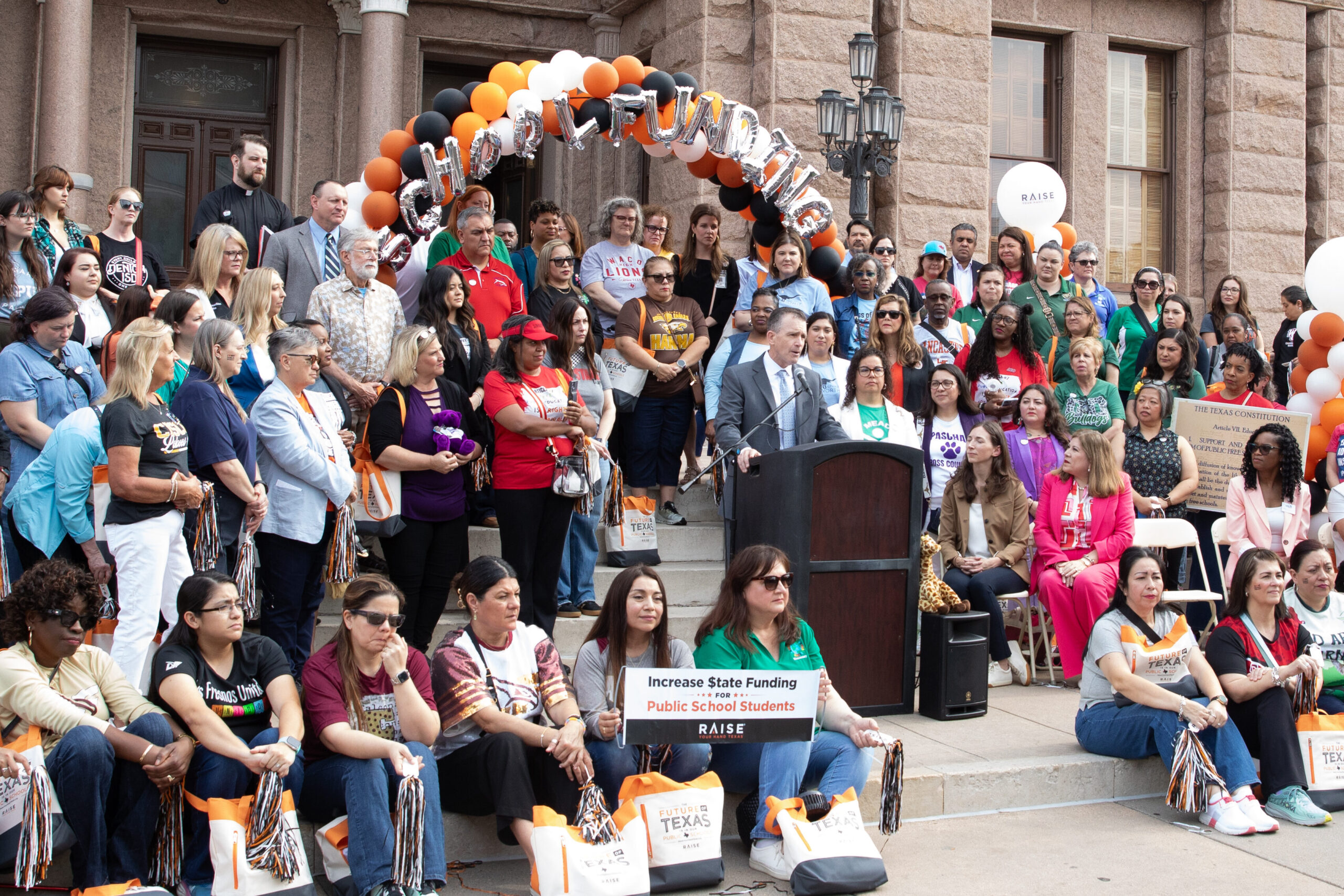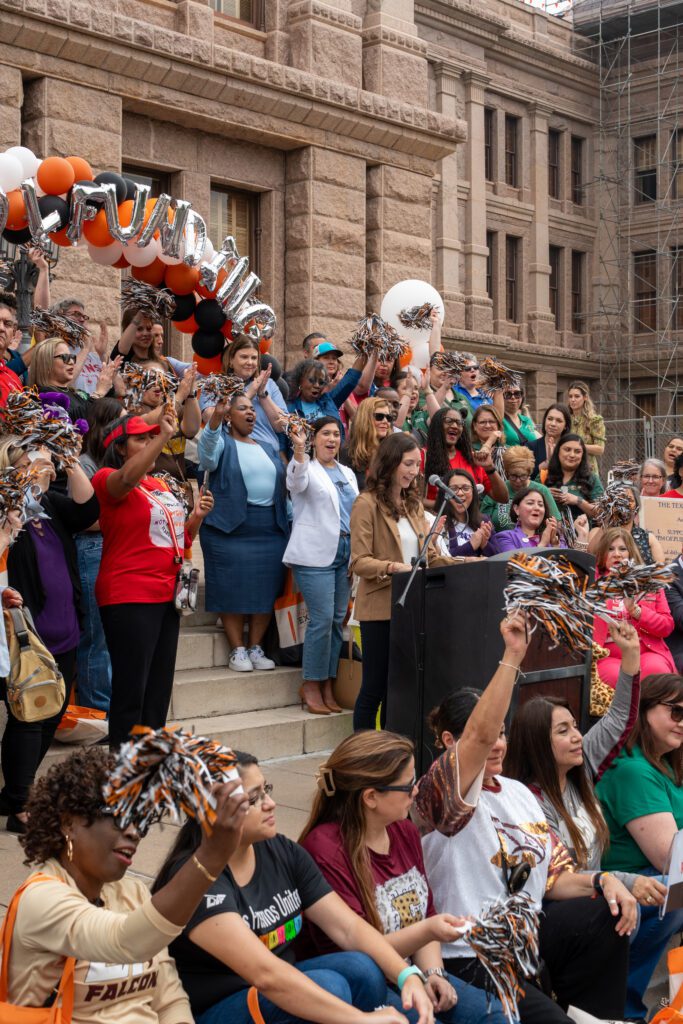
categories
School Budgets & Teacher Pay: How HB 2 and SB 26 Aim to Address the Texas Crisis

April 24, 2025

State leaders at the Capitol have less than 40 days left in the 89th Legislative Session to make important decisions for the state, while our locally elected public school district trustees are gearing up to face early summer deadlines to finalize their budgets for the next school year.
Rising operational costs driven by inflation have skyrocketed the prices local public school districts pay for everything from fuel to insurance, classroom art supplies to football equipment. The financial strain is not just a budget issue—it is a threat to the stability of Texas’ public schools, their ability to educate our youngest Texans, to retain qualified teachers, and to support our state’s long-term economic growth and workforce needs.
Funding Crisis Hits Schools Across Texas
Budget deficits have become the unfortunate norm in Texas public school districts across the state, due to a lack of significant state investment in the basic allotment since 2019. The basic allotment is the foundational building block of our school funding system: the base amount of state funding each school district or charter school receives for each student who attends.
North Texas school districts sounded alarm bells last year, noting the impact of inflation on their budgets. Every bus ride, meal delivery, and supply run now comes with a higher price tag than it did just a few years ago.
In Waco ISD, the district has seen fuel costs surge 49.5% over the past five years. Sunnyvale ISD paid just over $300,000 for property and casualty insurance in 2022; now the cost is over $500,000. In Belton ISD, the deficit for the 2024-25 school year was projected at $8.2 million, and in Leander ISD the Central Texas fast-growing district faces a $34.4 million deficit. Comal ISD faces an estimated $23.6 million shortfall. These are not isolated cases; they reflect a system stretched beyond its limits.
Some districts are facing budget deficits for a second straight year or have substantial deficits that necessitate more immediate and far-reaching cuts. Carrollton-Farmers Branch ISD trustees voted to close four schools recently, and Eanes ISD in Central Texas approved an elementary campus closure, as well as the elimination of the district’s popular Spanish Immersion program. Aldine ISD outside of Houston is closing nine campuses due to unsustainable budget deficits and a lack of state funding.
These numbers and budget cuts aren’t anomalies; they represent the reality that’s pushing local public schools to the brink. And while school leaders are forced to make up for state funding gaps with local tax dollars or budget cuts to staff and programs, Texas public schools face another challenge: the struggle to pay, recruit, and retain qualified teachers.
Teachers at the Breaking Point
At the heart of the teacher recruitment and retention crisis is a growing gap between rising costs and stagnant state funding, paired with attacks on the profession. According to TEA, teacher attrition rates surpassed 12% in the 2023-24 school year, reflecting the reality that teachers are fleeing the profession at an unsustainable rate. At the same time, there are fewer students in college seeking teaching as their chosen profession. And as local public schools try to fill those vacancies, another hard reality hits: the number of new teacher certifications continues to lag behind demand, leaving districts with fewer and fewer qualified applicants.

Texas lawmakers and education officials have acknowledged the teacher retention crisis, but meaningful action has yet to follow. The Teacher Vacancy Task Force (TVTF), convened from 2022 to 2023 to study the issue, confirmed what districts have long known – compensation is the single most important factor in keeping teachers in the profession. Their first recommendation was clear: competitive teacher salaries must be a top priority. The task force also outlined other necessary improvements, including stronger mentoring programs, reduced workloads, and better professional support. But even the best recommendations are meaningless without the funding to implement them.
Yet right now, from the Panhandle to the Rio Grande Valley, East Texas to the Permian Basin out to El Paso, schools across Texas are forced to make up the difference through local tax dollars, deficit spending, or cuts that directly impact teachers and students.
It is time for a change, Texas.
Texas Lawmakers Are on the Clock: Time to Invest
Texas lawmakers have the power to act, and the urgency to do so has never been greater. That’s the message more than 175 public school advocates delivered at the Texas Capitol on April 3, visiting all 188 legislative offices and urging lawmakers to make a historic investment in public schools, their students, and teachers.
Raise Your Hand Texas called on state lawmakers to approve a permanent pay raise for teachers and fund another historic $1,000 increase to the basic allotment, the primary per-pupil funding for public schools and their students. The state last increased the basic allotment in 2019 by $980. To keep up with inflation since then, the state would have to increase the basic allotment by more than $1,300.
As of today, HB 2 (the school funding bill) has been voted out of the House, and would provide $7.7 billion for various school funding increases over the next 2 years. The basic allotment increase in this bill is projected to be $395 higher per student, increasing from $6,160 to $6,555 by 2030.
Also as of today, SB 26 (the teacher pay bill) has been passed by the Senate and provides $4.3 billion for teacher compensation and incentives over the next two years, including $2.1 billion in 2025-26 and $2.4 billion in 2026-27. The cost increases to $3.6 billion annually by 2030.
Here is what the ongoing teacher pay raises will look like under SB 26:
- For school districts with 5,000 students or fewer, teachers with at least three but less than five years of experience: $5,000; Five or more years of experience: $10,000.
- For school districts with more than 5,000 students, teachers with at least three but less than five years of experience: $2,500; Five or more years of experience: $5,000.
Failing to act will not save the state money; it will cost more money in the long run. When schools lose teachers, districts not only spend more on turnover, hiring, and training, but they must rely on uncertified educators. When education quality declines, the long-term economic impact includes lower workforce readiness and decreased tax revenue from underprepared graduates. Investing in education is not a cost – it is a fiscal responsibility that ensures Texas’ future economic strength.
The solutions are clear, and the need is immediate. It’s time for the Texas Legislature to invest in the future of Texas, our students, and support their schools and teachers.



